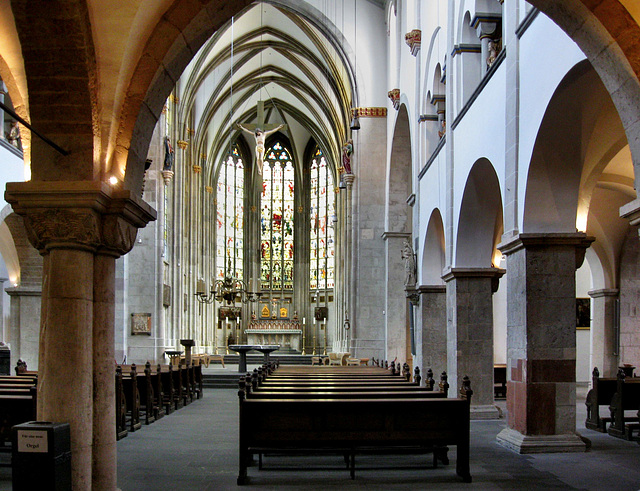Location
Lat, Lng: 50.945772, 6.954184
You can copy the above to your favourite mapping app.
Address: Sankt Ursula
You can copy the above to your favourite mapping app.
Address: Sankt Ursula
See also...
Keywords
Authorizations, license
-
Visible by: Everyone -
All rights reserved
-
293 visits
Cologne - St. Ursula


Cologne is the fourth-largest city in Germany - and one of the oldest. A Germanic tribe, the Ubii, had a settlement here, this was named by the Romans "Oppidum Ubiorum". In 50 AD, the Romans founded "Colonia Claudia Ara Agrippinensium", the city then became the provincial capital of "Germania Inferior".
Archaeological excavations revealed a building from the fourth century, this got converted and extended in the 6th century.
The Roman cemetery, on which St. Ursula was built, had been rummaged through in the 12th century in search of relics, as this church is connected to the legend of St. Ursula. According to this legend Ursula was on her way up the Rhine with eleven companions. Over the time this number changed to 11.000 virgins, as there were so many skeletons on this cemetery and the reliquary trade in the Middle Ages. They reached Basel from where they made a pilgrimage on foot to Rome. Pope Cyriakus joined them on their return journey. In Mainz Ursula's bridegroom Aetherius was finally baptized and from there the company reached Cologne, which was besieged by the Huns. Since the 11(000) virgins refused to marry the non-Christian Huns, they were murdered.
The church was damaged by the raid of the Normans in Cologne in 881/882. In 922 nuns from Gerresheim fled to Cologne from an invasion by the Hungarians and settled here.
When in 1106 the city fortification was extended and another large cemetery was discovered. The rich finds and the trade with relics led to prosperity, so that a complete new construction of the church became possible.
Mid 13th century the large Gothic choir, that was only used by canons and nuns, was added. Towards the end of the 15th century, the church underwent extensive renovations.
In 1802 the convent was dissolved and since 1804 the church serves the parish. At that time St. Ursula was in a desolate condition and got partially restored. End of the 19th century the church got finally rebuilt, but in 1945, after WWII, St. Ursula was a ruin.
The rebuilding was completed in 1978, when the "Goldene Kammer" ("Golden chamber") was reopened.
Archaeological excavations revealed a building from the fourth century, this got converted and extended in the 6th century.
The Roman cemetery, on which St. Ursula was built, had been rummaged through in the 12th century in search of relics, as this church is connected to the legend of St. Ursula. According to this legend Ursula was on her way up the Rhine with eleven companions. Over the time this number changed to 11.000 virgins, as there were so many skeletons on this cemetery and the reliquary trade in the Middle Ages. They reached Basel from where they made a pilgrimage on foot to Rome. Pope Cyriakus joined them on their return journey. In Mainz Ursula's bridegroom Aetherius was finally baptized and from there the company reached Cologne, which was besieged by the Huns. Since the 11(000) virgins refused to marry the non-Christian Huns, they were murdered.
The church was damaged by the raid of the Normans in Cologne in 881/882. In 922 nuns from Gerresheim fled to Cologne from an invasion by the Hungarians and settled here.
When in 1106 the city fortification was extended and another large cemetery was discovered. The rich finds and the trade with relics led to prosperity, so that a complete new construction of the church became possible.
Mid 13th century the large Gothic choir, that was only used by canons and nuns, was added. Towards the end of the 15th century, the church underwent extensive renovations.
In 1802 the convent was dissolved and since 1804 the church serves the parish. At that time St. Ursula was in a desolate condition and got partially restored. End of the 19th century the church got finally rebuilt, but in 1945, after WWII, St. Ursula was a ruin.
The rebuilding was completed in 1978, when the "Goldene Kammer" ("Golden chamber") was reopened.
Ernest CH has particularly liked this photo
- Keyboard shortcuts:
Jump to top
RSS feed- Latest comments - Subscribe to the comment feeds of this photo
- ipernity © 2007-2025
- Help & Contact
|
Club news
|
About ipernity
|
History |
ipernity Club & Prices |
Guide of good conduct
Donate | Group guidelines | Privacy policy | Terms of use | Statutes | In memoria -
Facebook
Twitter











Sign-in to write a comment.